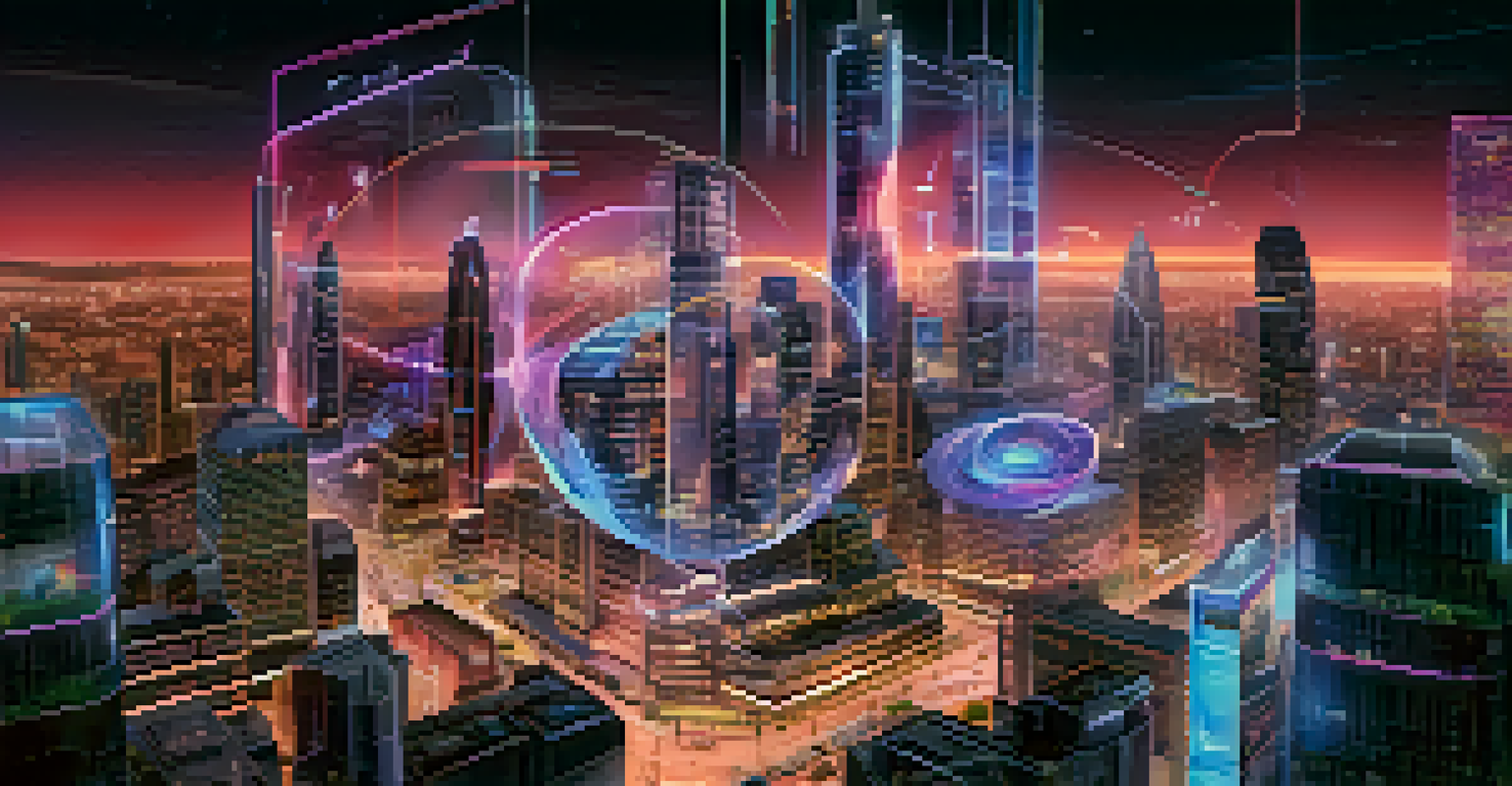NFTs and Digital Twins: Bridging the Gap between Virtual and Real

Understanding NFTs: The Digital Ownership Revolution
Non-Fungible Tokens, or NFTs, are unique digital assets that represent ownership of a specific item or piece of content on the blockchain. Unlike cryptocurrencies such as Bitcoin or Ethereum, which are interchangeable, each NFT is distinct, making it perfect for representing art, collectibles, or even virtual real estate. This uniqueness is what gives NFTs their value, creating a digital certificate of authenticity.
Digital assets are the new frontier of ownership, creating a paradigm shift in how we value our possessions.
One way to think about NFTs is to compare them to physical collectibles, like trading cards or rare coins. Just as a collector might pay a premium for a rare card, digital art or virtual assets can command high prices when authenticated as an NFT. This has opened up new avenues for artists and creators, allowing them to monetize their work in ways that were previously impossible.
However, owning an NFT doesn't mean you own the copyright to the underlying asset. Think of it like owning a signed print of a famous painting; you have the physical piece, but the original artist retains the rights. This nuance is essential for understanding the value and implications of NFTs in the digital landscape.
Digital Twins: What They Are and Why They Matter
Digital twins are virtual replicas of physical objects or systems, designed to simulate and analyze their real-world counterparts. Imagine having a miniature model of a city that allows urban planners to test out new designs or traffic patterns without disrupting the actual environment. This technology is not just limited to urban planning; it spans industries like manufacturing, healthcare, and even real estate.

The power of digital twins lies in their ability to provide real-time data. For instance, a digital twin of a wind turbine can monitor performance and predict maintenance needs, ultimately saving time and reducing costs. This leads to more efficient operations and better decision-making based on accurate, up-to-date information.
Unique Ownership with NFTs
NFTs provide a digital certificate of ownership for unique assets, much like collectibles in the physical world.
As technology evolves, the intersection of digital twins and the Internet of Things (IoT) becomes increasingly significant. By connecting physical objects to digital twins, businesses can gain deeper insights into their processes and improve overall efficiency. This relationship between the digital and physical worlds creates tremendous potential for innovation.
How NFTs and Digital Twins Intersect
The relationship between NFTs and digital twins is an emerging field that combines ownership and representation of both virtual and physical assets. Imagine owning an NFT that represents not just a piece of digital art, but also a digital twin of the physical artwork itself. This concept allows creators to provide added value by connecting the digital and physical worlds in meaningful ways.
The future is already here—it's just not very evenly distributed.
For instance, a designer could create a digital twin of a fashion item, allowing customers to visualize how it would look on them before purchase. The NFT could then serve as proof of purchase and ownership, creating a seamless experience that blends physical and virtual shopping. This could revolutionize e-commerce by enhancing customer engagement and satisfaction.
Additionally, this intersection can help protect intellectual property. With an NFT linked to a digital twin, creators can ensure that their work is not only unique but also traceable. This provides a layer of security that is particularly important in today's digital landscape, where copying and reproducing content is all too easy.
Real-World Applications of NFTs and Digital Twins
Various industries are starting to explore the benefits of combining NFTs with digital twins. In real estate, for example, a digital twin of a property can be sold as an NFT, giving buyers a unique piece of digital ownership alongside the physical property. This allows potential buyers to experience a virtual tour of their future home while also having proof of ownership.
In the realm of gaming, players can own NFTs that represent unique in-game items, while the game itself operates on a digital twin model that reflects the player's actions and choices. This creates a rich, immersive experience where players not only enjoy their virtual assets but also have a tangible sense of ownership that enhances their gameplay.
Digital Twins Enhance Realism
Digital twins offer virtual replicas of physical objects, enabling real-time data analysis and improved decision-making.
Moreover, industries like automotive are leveraging this technology to enhance customer experiences. Imagine purchasing a car that comes with an NFT representing its digital twin, offering maintenance records, performance data, and even customization options. This not only adds value but also builds trust between manufacturers and consumers.
Challenges in Merging NFTs and Digital Twins
Despite the exciting potential of NFTs and digital twins, several challenges need addressing. One major concern is the environmental impact of blockchain technology, particularly in NFTs, where energy-intensive mining processes can contribute to carbon emissions. As the world becomes more eco-conscious, finding sustainable solutions for digital ownership is critical.
Another challenge lies in the standardization of digital twins and their corresponding NFTs. With various platforms and technologies in play, ensuring compatibility and interoperability can be complex. This fragmentation could hinder the widespread adoption of these innovations, making it essential for industry stakeholders to collaborate and establish common standards.
Lastly, there’s the issue of consumer education. Many people are still unfamiliar with NFTs and digital twins, which can lead to skepticism or hesitation. Providing clear, accessible information will be key to encouraging broader acceptance and understanding of these technologies among the general public.
The Future of NFTs and Digital Twins
As technology continues to evolve, the future of NFTs and digital twins looks promising. We may see an increase in the integration of augmented reality (AR) and virtual reality (VR) with these technologies, creating even more immersive experiences. Imagine walking through a virtual gallery of art that you can also own in the real world, blurring the lines between physical and digital ownership.
Moreover, as businesses increasingly recognize the value of digital twins for data-driven decision-making, we can expect to see more industries adopting this technology. This could lead to innovative applications that we haven’t even imagined yet, transforming how we interact with both virtual and physical spaces.
Merging Technologies for Innovation
The intersection of NFTs and digital twins creates opportunities for enhanced consumer experiences and new business models.
Ultimately, the marriage of NFTs and digital twins has the potential to redefine ownership in the digital age. By bridging the gap between virtual and real, these technologies can create richer experiences for consumers and open up new opportunities for creators and businesses alike.
Conclusion: Embracing a New Digital Landscape
The convergence of NFTs and digital twins represents a significant shift in how we perceive ownership and interaction with digital assets. By merging these technologies, we can create a more immersive and meaningful connection between the virtual and physical worlds. This not only enriches the experience for consumers but also empowers creators and businesses to innovate in unprecedented ways.
As we navigate this new digital landscape, it’s essential to remain mindful of the challenges and responsibilities that come with these advancements. Sustainable practices, standardization, and consumer education will play critical roles in ensuring that these technologies benefit everyone involved.

In the end, embracing NFTs and digital twins could lead us to a future where the lines between physical and virtual ownership are beautifully intertwined, creating a richer, more dynamic world for all.